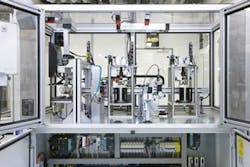Dan Hebert is a former senior technical editor for Control, Control Design and Industrial Networking.
The eFlow nebulizer, developed by Pari Pharma in Gräfelfing, Germany, has been used to treat cystic fibrosis patients for many years. The company is currently installing software to optimize automation of its production equipment, particularly through connectivity improvements.
The company is installing Beckhoff Automation's TwinCAT software on an existing PC, and linking this software to an existing Siemens S7-PLC. "Before the changeover, our technical infrastructure was somewhat inefficient," says Ronald Schmidt, project manager at Pari Pharma. "A very complex mix of control programs for the Siemens S7 PLC, as well as PC-based programs written in C++ and using National Instruments LabVIEW made maintenance without specialized programming knowledge nearly impossible. In the event of a fault, we had to call in external specialists on a regular basis."
The existing automation couldn't communicate with Oracle and SAP databases. Traceable parts manage-ment was needed for the complex production process, where two separate machining operations are executed in one manufacturing cell.
After the first production step, the part is removed, processed further and returned for another machining operation. The parts must be scanned and identified before each step. And the aerosol generator of the eFlow system passes through 12 production and testing stations.
Production of the aerosol generator for eFlow inhalation device takes 12 production and test facilities. Each part is scanned and unam-biguously identified using an Oracle database, a new control platform and an existing PLC.
"The data from the PLC had to be entered manually in the databases for further processing," laments Schmidt, and replacing the PLC was not an option.
"For years we looked for a machine control system that was able to communicate directly with the databases," Schmidt says. "We chose the TwinCAT Database Server in conjunction with a Profibus master terminal for the EtherCAT Terminal system from Beckhoff. However, we didn't want to and couldn't replace the old S7-PLC immediately during continuous operation. We were looking for an option to communicate with it via the Beckhoff system without the need for proprietary hardware."
The solution was provided by esqmate, GmbH, a system integration firm in Unterföhring, Germany. The company has an MPI software library for TwinCAT that ensures that the Beckhoff software can communicate directly with the Siemens PLC via a Beckhoff Profibus master terminal using the MPI protocol. No additional hardware, such as MPI/Ethernet gateways, was required.
The SAP system receives test data from the Oracle database, which is connected to the Beckhoff system. SAP then generates item lists, work schedules and approval reports, and manages inventory based on this data.
"Because direct communication is now possible between the existing S7-PLC, the Beckhoff platform, the Oracle database and our SAP system, we are at last able to link the control world with business management solutions," Schmidt says.






